The Impact of Virtual Learning Environment on Student Experience
VerifiedAdded on 2023/06/10
|14
|3133
|291
Report
AI Summary
This individual report, a DSR Assessment 2, examines the impact of Virtual Learning Environments (VLEs) on the learning experience of students at the University of Wales Trinity Saint David London Campus. The report begins with an introduction outlining the research aim, rationale, and objectives, followed by a literature review that explores the VLE concept, its benefits for student learning, and its importance in incorporating computer and internet usage. The methodology section details the research type, approach, data collection methods, sampling techniques, data analysis procedures, and ethical considerations. The results and findings section summarizes the outcomes of the study, highlighting the role of VLE in enhancing students' assignment completion abilities and digital skills. The conclusion and recommendations emphasize the significance of VLE in educational institutions, suggesting strategies for optimizing online learning environments. The report includes a class activity questionnaire and an Excel result table in the appendix.

DSR ASSESSMENT 2
INDIVIDUAL REPORT
1
INDIVIDUAL REPORT
1
Paraphrase This Document
Need a fresh take? Get an instant paraphrase of this document with our AI Paraphraser
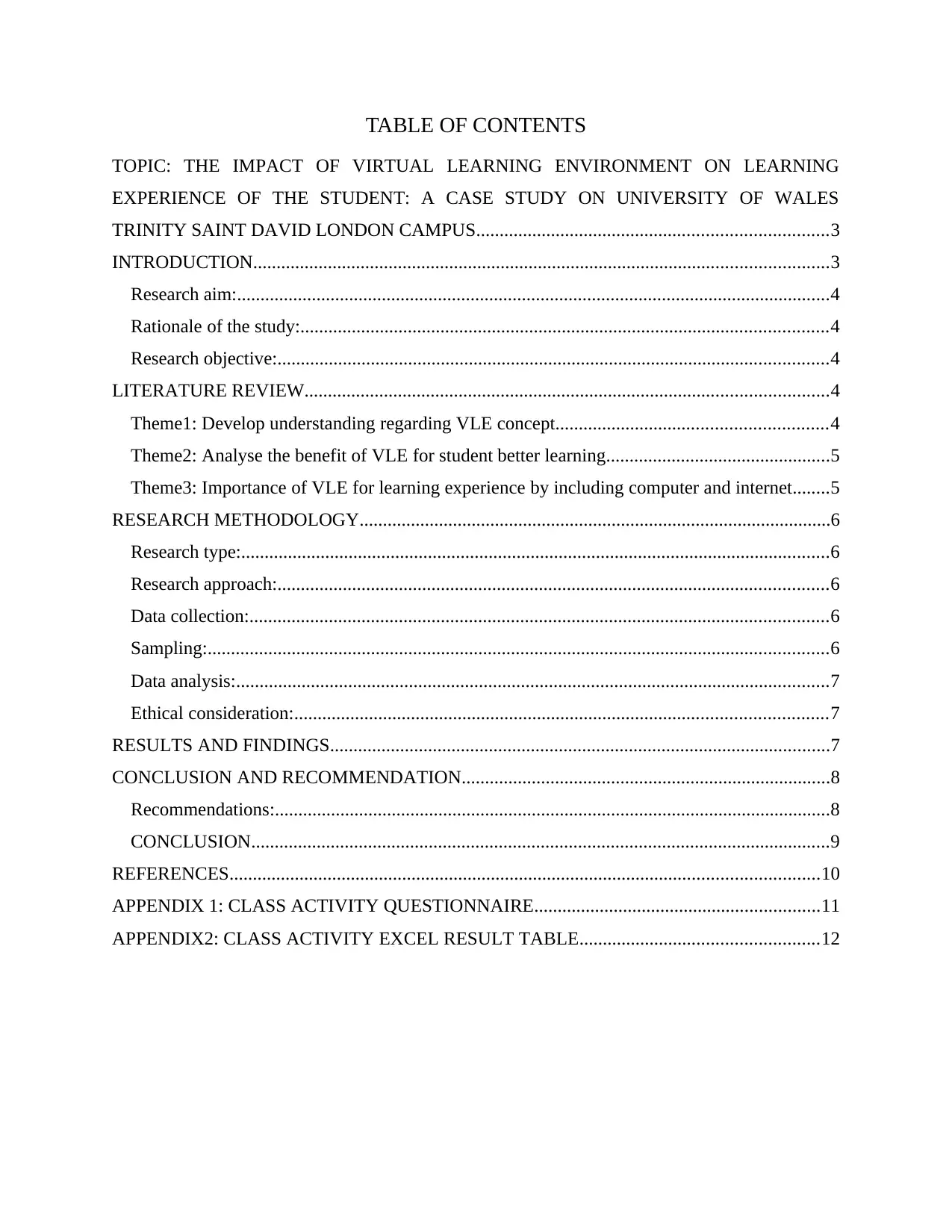
TABLE OF CONTENTS
TOPIC: THE IMPACT OF VIRTUAL LEARNING ENVIRONMENT ON LEARNING
EXPERIENCE OF THE STUDENT: A CASE STUDY ON UNIVERSITY OF WALES
TRINITY SAINT DAVID LONDON CAMPUS...........................................................................3
INTRODUCTION...........................................................................................................................3
Research aim:...............................................................................................................................4
Rationale of the study:.................................................................................................................4
Research objective:......................................................................................................................4
LITERATURE REVIEW................................................................................................................4
Theme1: Develop understanding regarding VLE concept..........................................................4
Theme2: Analyse the benefit of VLE for student better learning................................................5
Theme3: Importance of VLE for learning experience by including computer and internet........5
RESEARCH METHODOLOGY.....................................................................................................6
Research type:..............................................................................................................................6
Research approach:......................................................................................................................6
Data collection:............................................................................................................................6
Sampling:.....................................................................................................................................6
Data analysis:...............................................................................................................................7
Ethical consideration:..................................................................................................................7
RESULTS AND FINDINGS...........................................................................................................7
CONCLUSION AND RECOMMENDATION...............................................................................8
Recommendations:.......................................................................................................................8
CONCLUSION............................................................................................................................9
REFERENCES..............................................................................................................................10
APPENDIX 1: CLASS ACTIVITY QUESTIONNAIRE.............................................................11
APPENDIX2: CLASS ACTIVITY EXCEL RESULT TABLE...................................................12
TOPIC: THE IMPACT OF VIRTUAL LEARNING ENVIRONMENT ON LEARNING
EXPERIENCE OF THE STUDENT: A CASE STUDY ON UNIVERSITY OF WALES
TRINITY SAINT DAVID LONDON CAMPUS...........................................................................3
INTRODUCTION...........................................................................................................................3
Research aim:...............................................................................................................................4
Rationale of the study:.................................................................................................................4
Research objective:......................................................................................................................4
LITERATURE REVIEW................................................................................................................4
Theme1: Develop understanding regarding VLE concept..........................................................4
Theme2: Analyse the benefit of VLE for student better learning................................................5
Theme3: Importance of VLE for learning experience by including computer and internet........5
RESEARCH METHODOLOGY.....................................................................................................6
Research type:..............................................................................................................................6
Research approach:......................................................................................................................6
Data collection:............................................................................................................................6
Sampling:.....................................................................................................................................6
Data analysis:...............................................................................................................................7
Ethical consideration:..................................................................................................................7
RESULTS AND FINDINGS...........................................................................................................7
CONCLUSION AND RECOMMENDATION...............................................................................8
Recommendations:.......................................................................................................................8
CONCLUSION............................................................................................................................9
REFERENCES..............................................................................................................................10
APPENDIX 1: CLASS ACTIVITY QUESTIONNAIRE.............................................................11
APPENDIX2: CLASS ACTIVITY EXCEL RESULT TABLE...................................................12
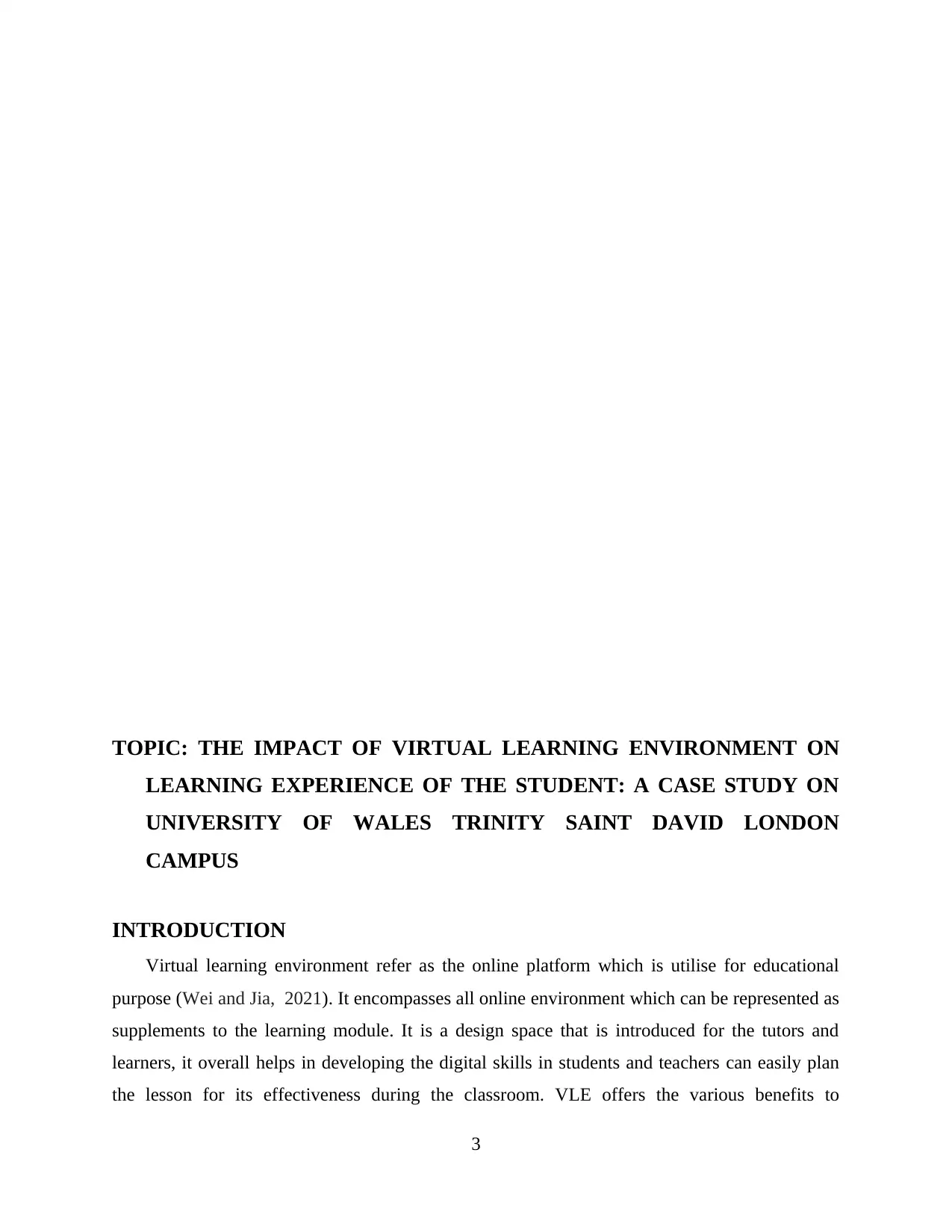
TOPIC: THE IMPACT OF VIRTUAL LEARNING ENVIRONMENT ON
LEARNING EXPERIENCE OF THE STUDENT: A CASE STUDY ON
UNIVERSITY OF WALES TRINITY SAINT DAVID LONDON
CAMPUS
INTRODUCTION
Virtual learning environment refer as the online platform which is utilise for educational
purpose (Wei and Jia, 2021). It encompasses all online environment which can be represented as
supplements to the learning module. It is a design space that is introduced for the tutors and
learners, it overall helps in developing the digital skills in students and teachers can easily plan
the lesson for its effectiveness during the classroom. VLE offers the various benefits to
3
LEARNING EXPERIENCE OF THE STUDENT: A CASE STUDY ON
UNIVERSITY OF WALES TRINITY SAINT DAVID LONDON
CAMPUS
INTRODUCTION
Virtual learning environment refer as the online platform which is utilise for educational
purpose (Wei and Jia, 2021). It encompasses all online environment which can be represented as
supplements to the learning module. It is a design space that is introduced for the tutors and
learners, it overall helps in developing the digital skills in students and teachers can easily plan
the lesson for its effectiveness during the classroom. VLE offers the various benefits to
3
⊘ This is a preview!⊘
Do you want full access?
Subscribe today to unlock all pages.

Trusted by 1+ million students worldwide
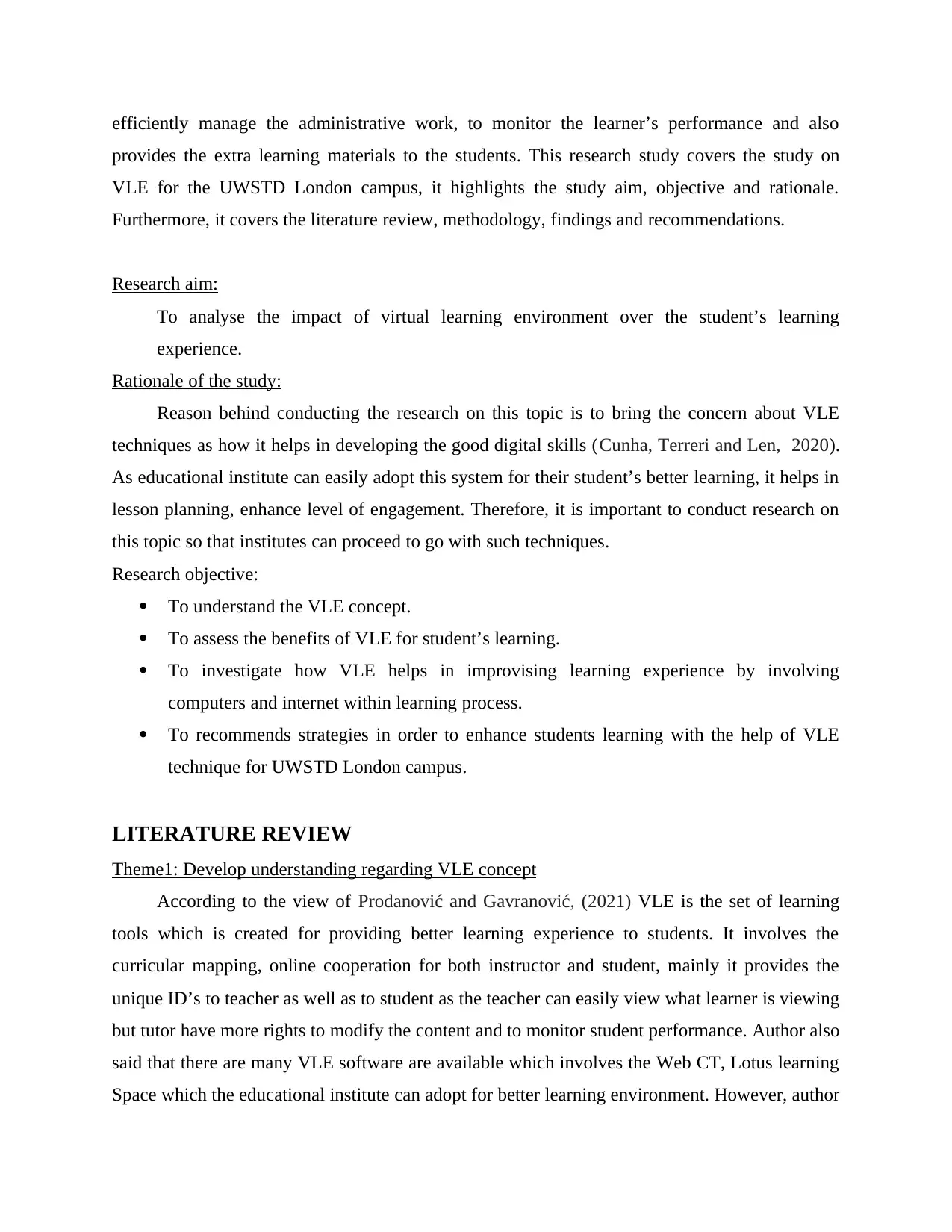
efficiently manage the administrative work, to monitor the learner’s performance and also
provides the extra learning materials to the students. This research study covers the study on
VLE for the UWSTD London campus, it highlights the study aim, objective and rationale.
Furthermore, it covers the literature review, methodology, findings and recommendations.
Research aim:
To analyse the impact of virtual learning environment over the student’s learning
experience.
Rationale of the study:
Reason behind conducting the research on this topic is to bring the concern about VLE
techniques as how it helps in developing the good digital skills (Cunha, Terreri and Len, 2020).
As educational institute can easily adopt this system for their student’s better learning, it helps in
lesson planning, enhance level of engagement. Therefore, it is important to conduct research on
this topic so that institutes can proceed to go with such techniques.
Research objective:
To understand the VLE concept.
To assess the benefits of VLE for student’s learning.
To investigate how VLE helps in improvising learning experience by involving
computers and internet within learning process.
To recommends strategies in order to enhance students learning with the help of VLE
technique for UWSTD London campus.
LITERATURE REVIEW
Theme1: Develop understanding regarding VLE concept
According to the view of Prodanović and Gavranović, (2021) VLE is the set of learning
tools which is created for providing better learning experience to students. It involves the
curricular mapping, online cooperation for both instructor and student, mainly it provides the
unique ID’s to teacher as well as to student as the teacher can easily view what learner is viewing
but tutor have more rights to modify the content and to monitor student performance. Author also
said that there are many VLE software are available which involves the Web CT, Lotus learning
Space which the educational institute can adopt for better learning environment. However, author
provides the extra learning materials to the students. This research study covers the study on
VLE for the UWSTD London campus, it highlights the study aim, objective and rationale.
Furthermore, it covers the literature review, methodology, findings and recommendations.
Research aim:
To analyse the impact of virtual learning environment over the student’s learning
experience.
Rationale of the study:
Reason behind conducting the research on this topic is to bring the concern about VLE
techniques as how it helps in developing the good digital skills (Cunha, Terreri and Len, 2020).
As educational institute can easily adopt this system for their student’s better learning, it helps in
lesson planning, enhance level of engagement. Therefore, it is important to conduct research on
this topic so that institutes can proceed to go with such techniques.
Research objective:
To understand the VLE concept.
To assess the benefits of VLE for student’s learning.
To investigate how VLE helps in improvising learning experience by involving
computers and internet within learning process.
To recommends strategies in order to enhance students learning with the help of VLE
technique for UWSTD London campus.
LITERATURE REVIEW
Theme1: Develop understanding regarding VLE concept
According to the view of Prodanović and Gavranović, (2021) VLE is the set of learning
tools which is created for providing better learning experience to students. It involves the
curricular mapping, online cooperation for both instructor and student, mainly it provides the
unique ID’s to teacher as well as to student as the teacher can easily view what learner is viewing
but tutor have more rights to modify the content and to monitor student performance. Author also
said that there are many VLE software are available which involves the Web CT, Lotus learning
Space which the educational institute can adopt for better learning environment. However, author
Paraphrase This Document
Need a fresh take? Get an instant paraphrase of this document with our AI Paraphraser
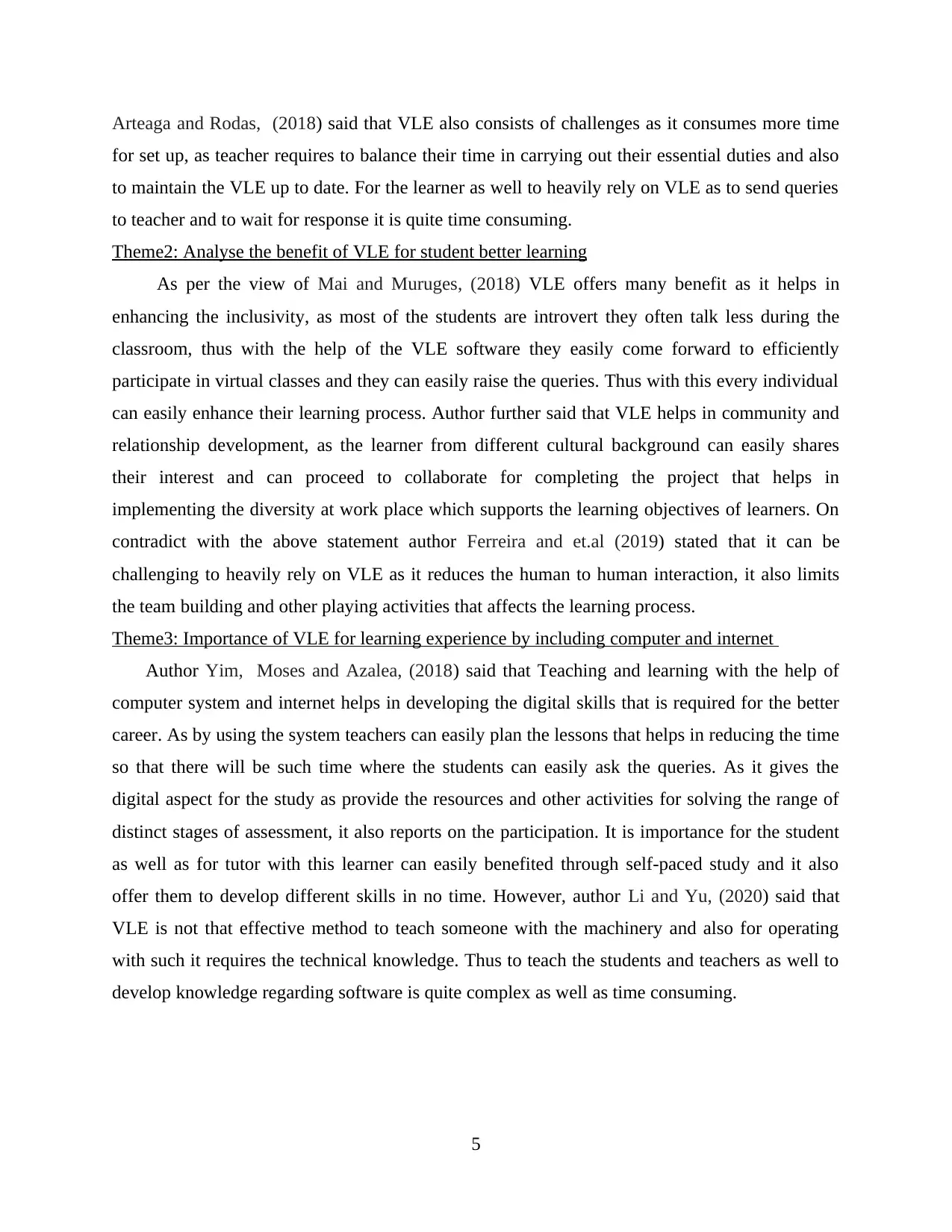
Arteaga and Rodas, (2018) said that VLE also consists of challenges as it consumes more time
for set up, as teacher requires to balance their time in carrying out their essential duties and also
to maintain the VLE up to date. For the learner as well to heavily rely on VLE as to send queries
to teacher and to wait for response it is quite time consuming.
Theme2: Analyse the benefit of VLE for student better learning
As per the view of Mai and Muruges, (2018) VLE offers many benefit as it helps in
enhancing the inclusivity, as most of the students are introvert they often talk less during the
classroom, thus with the help of the VLE software they easily come forward to efficiently
participate in virtual classes and they can easily raise the queries. Thus with this every individual
can easily enhance their learning process. Author further said that VLE helps in community and
relationship development, as the learner from different cultural background can easily shares
their interest and can proceed to collaborate for completing the project that helps in
implementing the diversity at work place which supports the learning objectives of learners. On
contradict with the above statement author Ferreira and et.al (2019) stated that it can be
challenging to heavily rely on VLE as it reduces the human to human interaction, it also limits
the team building and other playing activities that affects the learning process.
Theme3: Importance of VLE for learning experience by including computer and internet
Author Yim, Moses and Azalea, (2018) said that Teaching and learning with the help of
computer system and internet helps in developing the digital skills that is required for the better
career. As by using the system teachers can easily plan the lessons that helps in reducing the time
so that there will be such time where the students can easily ask the queries. As it gives the
digital aspect for the study as provide the resources and other activities for solving the range of
distinct stages of assessment, it also reports on the participation. It is importance for the student
as well as for tutor with this learner can easily benefited through self-paced study and it also
offer them to develop different skills in no time. However, author Li and Yu, (2020) said that
VLE is not that effective method to teach someone with the machinery and also for operating
with such it requires the technical knowledge. Thus to teach the students and teachers as well to
develop knowledge regarding software is quite complex as well as time consuming.
5
for set up, as teacher requires to balance their time in carrying out their essential duties and also
to maintain the VLE up to date. For the learner as well to heavily rely on VLE as to send queries
to teacher and to wait for response it is quite time consuming.
Theme2: Analyse the benefit of VLE for student better learning
As per the view of Mai and Muruges, (2018) VLE offers many benefit as it helps in
enhancing the inclusivity, as most of the students are introvert they often talk less during the
classroom, thus with the help of the VLE software they easily come forward to efficiently
participate in virtual classes and they can easily raise the queries. Thus with this every individual
can easily enhance their learning process. Author further said that VLE helps in community and
relationship development, as the learner from different cultural background can easily shares
their interest and can proceed to collaborate for completing the project that helps in
implementing the diversity at work place which supports the learning objectives of learners. On
contradict with the above statement author Ferreira and et.al (2019) stated that it can be
challenging to heavily rely on VLE as it reduces the human to human interaction, it also limits
the team building and other playing activities that affects the learning process.
Theme3: Importance of VLE for learning experience by including computer and internet
Author Yim, Moses and Azalea, (2018) said that Teaching and learning with the help of
computer system and internet helps in developing the digital skills that is required for the better
career. As by using the system teachers can easily plan the lessons that helps in reducing the time
so that there will be such time where the students can easily ask the queries. As it gives the
digital aspect for the study as provide the resources and other activities for solving the range of
distinct stages of assessment, it also reports on the participation. It is importance for the student
as well as for tutor with this learner can easily benefited through self-paced study and it also
offer them to develop different skills in no time. However, author Li and Yu, (2020) said that
VLE is not that effective method to teach someone with the machinery and also for operating
with such it requires the technical knowledge. Thus to teach the students and teachers as well to
develop knowledge regarding software is quite complex as well as time consuming.
5
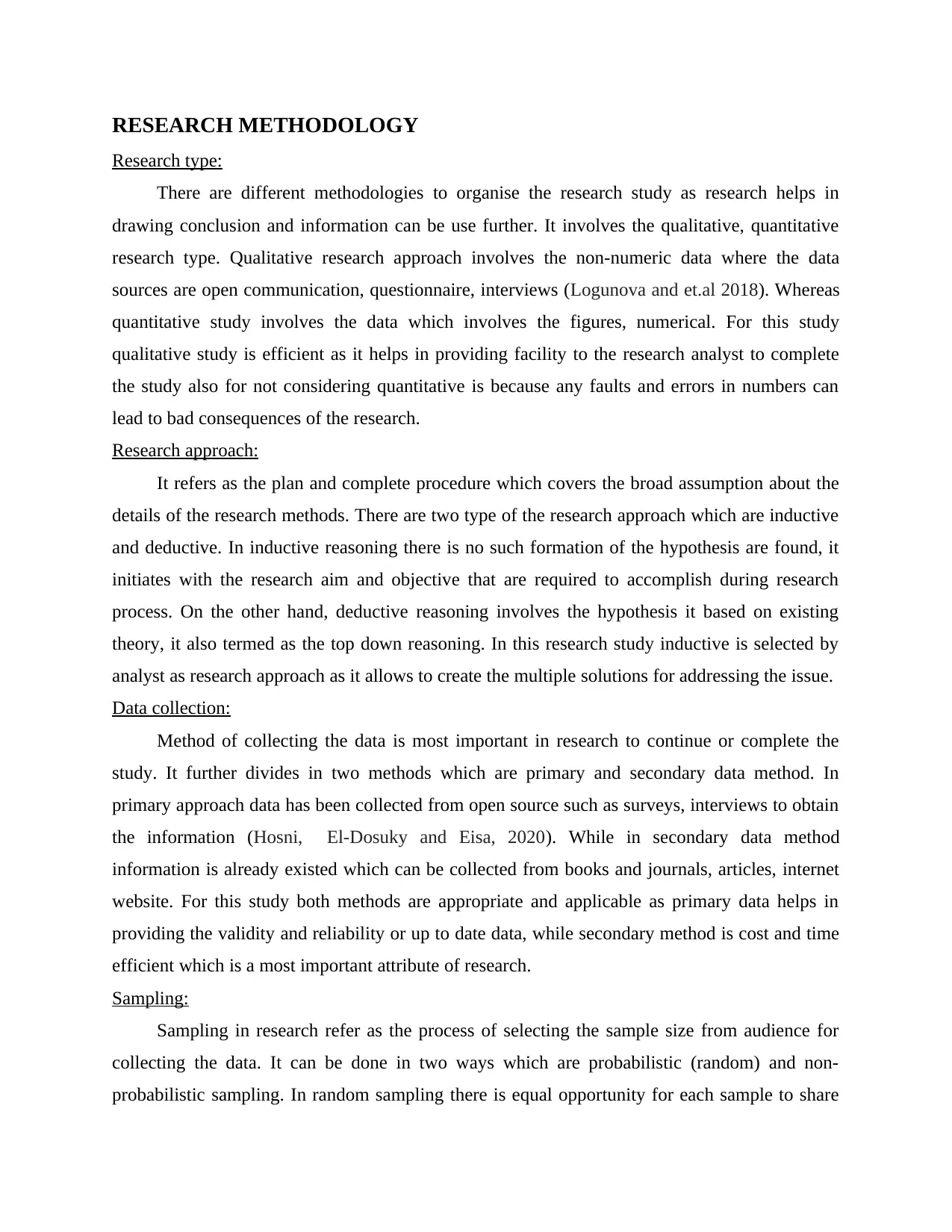
RESEARCH METHODOLOGY
Research type:
There are different methodologies to organise the research study as research helps in
drawing conclusion and information can be use further. It involves the qualitative, quantitative
research type. Qualitative research approach involves the non-numeric data where the data
sources are open communication, questionnaire, interviews (Logunova and et.al 2018). Whereas
quantitative study involves the data which involves the figures, numerical. For this study
qualitative study is efficient as it helps in providing facility to the research analyst to complete
the study also for not considering quantitative is because any faults and errors in numbers can
lead to bad consequences of the research.
Research approach:
It refers as the plan and complete procedure which covers the broad assumption about the
details of the research methods. There are two type of the research approach which are inductive
and deductive. In inductive reasoning there is no such formation of the hypothesis are found, it
initiates with the research aim and objective that are required to accomplish during research
process. On the other hand, deductive reasoning involves the hypothesis it based on existing
theory, it also termed as the top down reasoning. In this research study inductive is selected by
analyst as research approach as it allows to create the multiple solutions for addressing the issue.
Data collection:
Method of collecting the data is most important in research to continue or complete the
study. It further divides in two methods which are primary and secondary data method. In
primary approach data has been collected from open source such as surveys, interviews to obtain
the information (Hosni, El-Dosuky and Eisa, 2020). While in secondary data method
information is already existed which can be collected from books and journals, articles, internet
website. For this study both methods are appropriate and applicable as primary data helps in
providing the validity and reliability or up to date data, while secondary method is cost and time
efficient which is a most important attribute of research.
Sampling:
Sampling in research refer as the process of selecting the sample size from audience for
collecting the data. It can be done in two ways which are probabilistic (random) and non-
probabilistic sampling. In random sampling there is equal opportunity for each sample to share
Research type:
There are different methodologies to organise the research study as research helps in
drawing conclusion and information can be use further. It involves the qualitative, quantitative
research type. Qualitative research approach involves the non-numeric data where the data
sources are open communication, questionnaire, interviews (Logunova and et.al 2018). Whereas
quantitative study involves the data which involves the figures, numerical. For this study
qualitative study is efficient as it helps in providing facility to the research analyst to complete
the study also for not considering quantitative is because any faults and errors in numbers can
lead to bad consequences of the research.
Research approach:
It refers as the plan and complete procedure which covers the broad assumption about the
details of the research methods. There are two type of the research approach which are inductive
and deductive. In inductive reasoning there is no such formation of the hypothesis are found, it
initiates with the research aim and objective that are required to accomplish during research
process. On the other hand, deductive reasoning involves the hypothesis it based on existing
theory, it also termed as the top down reasoning. In this research study inductive is selected by
analyst as research approach as it allows to create the multiple solutions for addressing the issue.
Data collection:
Method of collecting the data is most important in research to continue or complete the
study. It further divides in two methods which are primary and secondary data method. In
primary approach data has been collected from open source such as surveys, interviews to obtain
the information (Hosni, El-Dosuky and Eisa, 2020). While in secondary data method
information is already existed which can be collected from books and journals, articles, internet
website. For this study both methods are appropriate and applicable as primary data helps in
providing the validity and reliability or up to date data, while secondary method is cost and time
efficient which is a most important attribute of research.
Sampling:
Sampling in research refer as the process of selecting the sample size from audience for
collecting the data. It can be done in two ways which are probabilistic (random) and non-
probabilistic sampling. In random sampling there is equal opportunity for each sample to share
⊘ This is a preview!⊘
Do you want full access?
Subscribe today to unlock all pages.

Trusted by 1+ million students worldwide
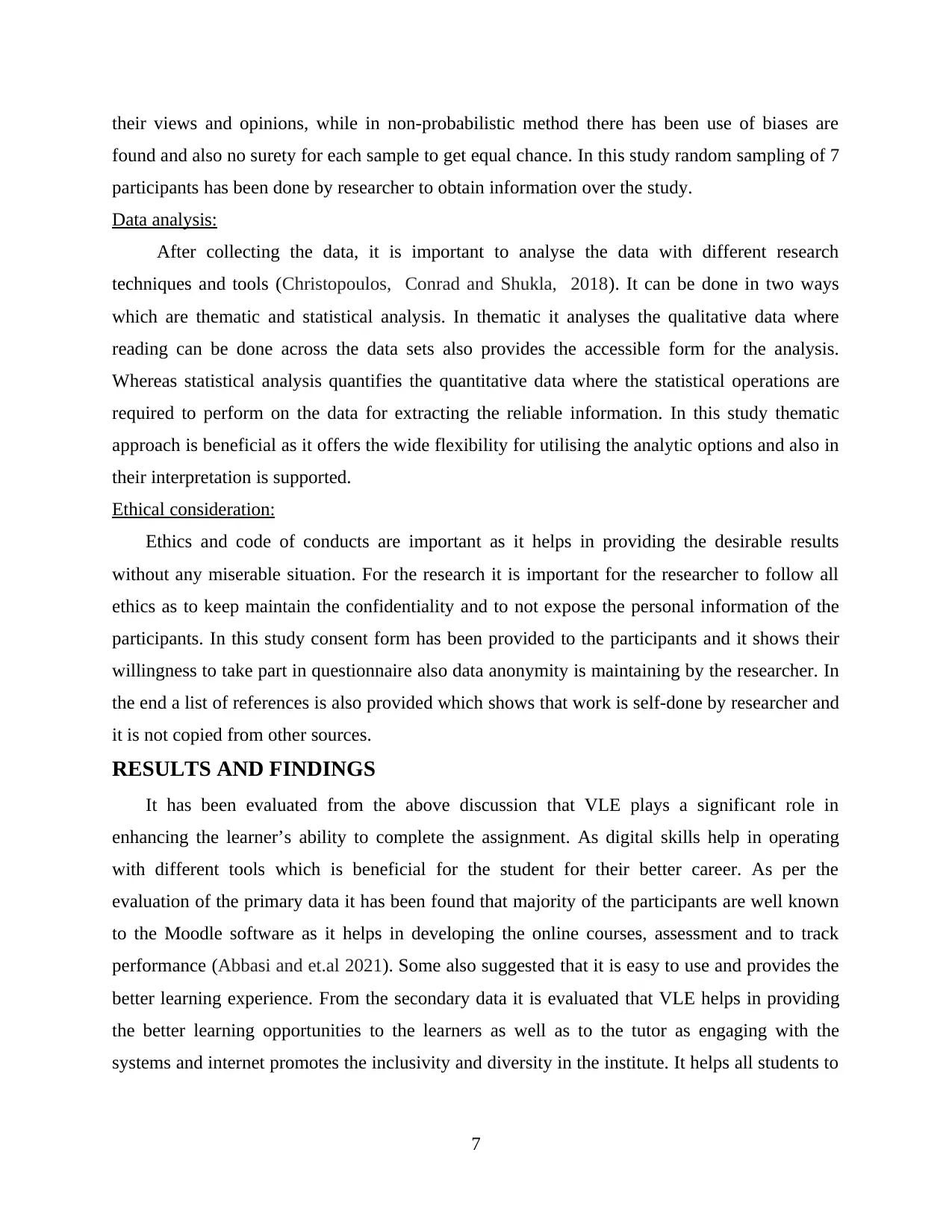
their views and opinions, while in non-probabilistic method there has been use of biases are
found and also no surety for each sample to get equal chance. In this study random sampling of 7
participants has been done by researcher to obtain information over the study.
Data analysis:
After collecting the data, it is important to analyse the data with different research
techniques and tools (Christopoulos, Conrad and Shukla, 2018). It can be done in two ways
which are thematic and statistical analysis. In thematic it analyses the qualitative data where
reading can be done across the data sets also provides the accessible form for the analysis.
Whereas statistical analysis quantifies the quantitative data where the statistical operations are
required to perform on the data for extracting the reliable information. In this study thematic
approach is beneficial as it offers the wide flexibility for utilising the analytic options and also in
their interpretation is supported.
Ethical consideration:
Ethics and code of conducts are important as it helps in providing the desirable results
without any miserable situation. For the research it is important for the researcher to follow all
ethics as to keep maintain the confidentiality and to not expose the personal information of the
participants. In this study consent form has been provided to the participants and it shows their
willingness to take part in questionnaire also data anonymity is maintaining by the researcher. In
the end a list of references is also provided which shows that work is self-done by researcher and
it is not copied from other sources.
RESULTS AND FINDINGS
It has been evaluated from the above discussion that VLE plays a significant role in
enhancing the learner’s ability to complete the assignment. As digital skills help in operating
with different tools which is beneficial for the student for their better career. As per the
evaluation of the primary data it has been found that majority of the participants are well known
to the Moodle software as it helps in developing the online courses, assessment and to track
performance (Abbasi and et.al 2021). Some also suggested that it is easy to use and provides the
better learning experience. From the secondary data it is evaluated that VLE helps in providing
the better learning opportunities to the learners as well as to the tutor as engaging with the
systems and internet promotes the inclusivity and diversity in the institute. It helps all students to
7
found and also no surety for each sample to get equal chance. In this study random sampling of 7
participants has been done by researcher to obtain information over the study.
Data analysis:
After collecting the data, it is important to analyse the data with different research
techniques and tools (Christopoulos, Conrad and Shukla, 2018). It can be done in two ways
which are thematic and statistical analysis. In thematic it analyses the qualitative data where
reading can be done across the data sets also provides the accessible form for the analysis.
Whereas statistical analysis quantifies the quantitative data where the statistical operations are
required to perform on the data for extracting the reliable information. In this study thematic
approach is beneficial as it offers the wide flexibility for utilising the analytic options and also in
their interpretation is supported.
Ethical consideration:
Ethics and code of conducts are important as it helps in providing the desirable results
without any miserable situation. For the research it is important for the researcher to follow all
ethics as to keep maintain the confidentiality and to not expose the personal information of the
participants. In this study consent form has been provided to the participants and it shows their
willingness to take part in questionnaire also data anonymity is maintaining by the researcher. In
the end a list of references is also provided which shows that work is self-done by researcher and
it is not copied from other sources.
RESULTS AND FINDINGS
It has been evaluated from the above discussion that VLE plays a significant role in
enhancing the learner’s ability to complete the assignment. As digital skills help in operating
with different tools which is beneficial for the student for their better career. As per the
evaluation of the primary data it has been found that majority of the participants are well known
to the Moodle software as it helps in developing the online courses, assessment and to track
performance (Abbasi and et.al 2021). Some also suggested that it is easy to use and provides the
better learning experience. From the secondary data it is evaluated that VLE helps in providing
the better learning opportunities to the learners as well as to the tutor as engaging with the
systems and internet promotes the inclusivity and diversity in the institute. It helps all students to
7
Paraphrase This Document
Need a fresh take? Get an instant paraphrase of this document with our AI Paraphraser

share their common interest and knowledge, often helps in enhancing the collaboration to
delivers the project which enhance the communication and interaction among the students.
Overall it has been evaluated from the above that Moodle software helps in enhancing the
digital skills of the students as they can easily raise their queries if they encountered in course
also it encourages the communication and interaction so that efficiently learning objectives can
be achieved (Söken and Nygreen, 2021). Also with this there is a formation of the feedback
culture is found as to give and take feedbacks from peers helps in improvising the learning
practices. Overall VLE techniques are beneficial and helpful in providing the accessible and
learning environment that supports learners to enhance their knowledge and develops different
skill set.
CONCLUSION AND RECOMMENDATION
Recommendations:
Introduction of VLE in educational institute helps in providing numerous benefits as to easily
manage the administration, teaching activities and learner’s performance. It is important for the
learning institute to have specific arrangement for the software that guides them in providing the
equal chance to each students (Camilleri and Camilleri, 2020). Some recommendations are as
follows:
UWSTD London campus can proceed to provide the online learning environment so that
it supports the learning.
Technology will enable the institution to go beyond the substitution and they can easily
redefine the learning. As by using this technique they can easily proceed to develop the
accessible content so that it will help in eliminating the obstacles of comprehension and
also to ensure that the content is accessible to all students which also means student with
disability can also access the content.
VLE also helps in strengthening the relationship among the teacher and student which is
necessary for better achievement of the learning goals (García-Esteban and et.al 2019).
Also with the continually feedback from tutors will help the student to improvise in
themselves for their better learning process, as well as teacher can also able to take the
feedbacks from peers and students over the VLE tool for enhancing best teaching
practices.
delivers the project which enhance the communication and interaction among the students.
Overall it has been evaluated from the above that Moodle software helps in enhancing the
digital skills of the students as they can easily raise their queries if they encountered in course
also it encourages the communication and interaction so that efficiently learning objectives can
be achieved (Söken and Nygreen, 2021). Also with this there is a formation of the feedback
culture is found as to give and take feedbacks from peers helps in improvising the learning
practices. Overall VLE techniques are beneficial and helpful in providing the accessible and
learning environment that supports learners to enhance their knowledge and develops different
skill set.
CONCLUSION AND RECOMMENDATION
Recommendations:
Introduction of VLE in educational institute helps in providing numerous benefits as to easily
manage the administration, teaching activities and learner’s performance. It is important for the
learning institute to have specific arrangement for the software that guides them in providing the
equal chance to each students (Camilleri and Camilleri, 2020). Some recommendations are as
follows:
UWSTD London campus can proceed to provide the online learning environment so that
it supports the learning.
Technology will enable the institution to go beyond the substitution and they can easily
redefine the learning. As by using this technique they can easily proceed to develop the
accessible content so that it will help in eliminating the obstacles of comprehension and
also to ensure that the content is accessible to all students which also means student with
disability can also access the content.
VLE also helps in strengthening the relationship among the teacher and student which is
necessary for better achievement of the learning goals (García-Esteban and et.al 2019).
Also with the continually feedback from tutors will help the student to improvise in
themselves for their better learning process, as well as teacher can also able to take the
feedbacks from peers and students over the VLE tool for enhancing best teaching
practices.
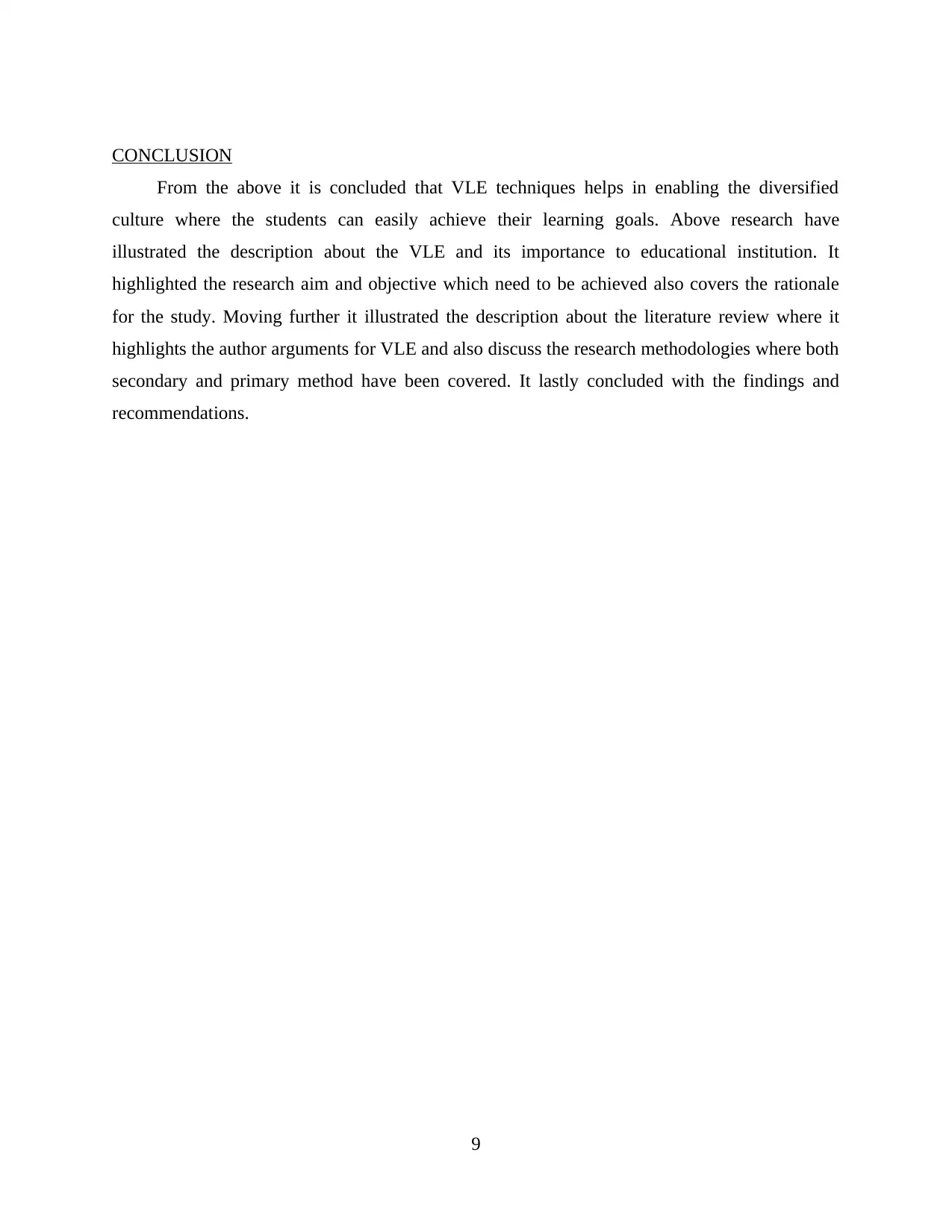
CONCLUSION
From the above it is concluded that VLE techniques helps in enabling the diversified
culture where the students can easily achieve their learning goals. Above research have
illustrated the description about the VLE and its importance to educational institution. It
highlighted the research aim and objective which need to be achieved also covers the rationale
for the study. Moving further it illustrated the description about the literature review where it
highlights the author arguments for VLE and also discuss the research methodologies where both
secondary and primary method have been covered. It lastly concluded with the findings and
recommendations.
9
From the above it is concluded that VLE techniques helps in enabling the diversified
culture where the students can easily achieve their learning goals. Above research have
illustrated the description about the VLE and its importance to educational institution. It
highlighted the research aim and objective which need to be achieved also covers the rationale
for the study. Moving further it illustrated the description about the literature review where it
highlights the author arguments for VLE and also discuss the research methodologies where both
secondary and primary method have been covered. It lastly concluded with the findings and
recommendations.
9
⊘ This is a preview!⊘
Do you want full access?
Subscribe today to unlock all pages.

Trusted by 1+ million students worldwide
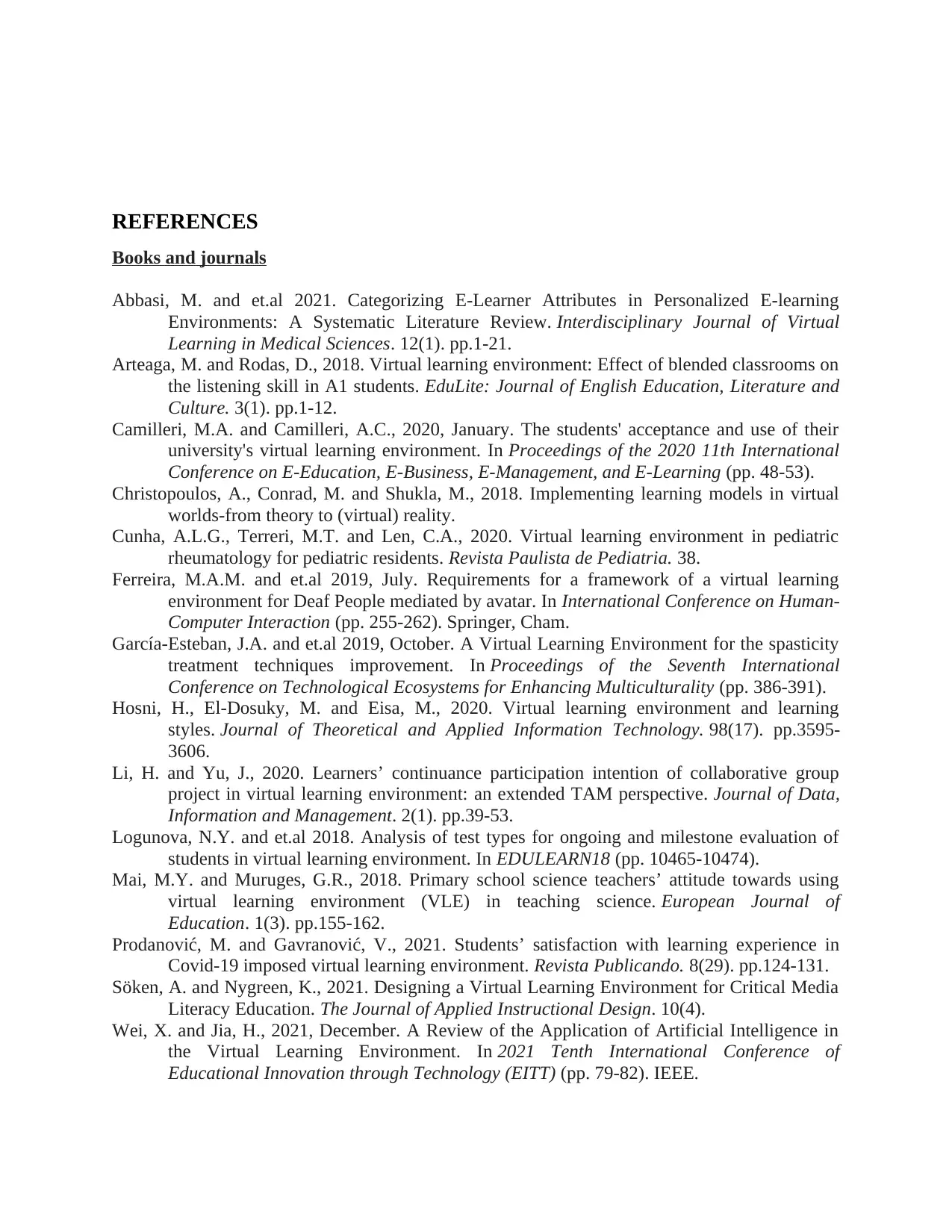
REFERENCES
Books and journals
Abbasi, M. and et.al 2021. Categorizing E-Learner Attributes in Personalized E-learning
Environments: A Systematic Literature Review. Interdisciplinary Journal of Virtual
Learning in Medical Sciences. 12(1). pp.1-21.
Arteaga, M. and Rodas, D., 2018. Virtual learning environment: Effect of blended classrooms on
the listening skill in A1 students. EduLite: Journal of English Education, Literature and
Culture. 3(1). pp.1-12.
Camilleri, M.A. and Camilleri, A.C., 2020, January. The students' acceptance and use of their
university's virtual learning environment. In Proceedings of the 2020 11th International
Conference on E-Education, E-Business, E-Management, and E-Learning (pp. 48-53).
Christopoulos, A., Conrad, M. and Shukla, M., 2018. Implementing learning models in virtual
worlds-from theory to (virtual) reality.
Cunha, A.L.G., Terreri, M.T. and Len, C.A., 2020. Virtual learning environment in pediatric
rheumatology for pediatric residents. Revista Paulista de Pediatria. 38.
Ferreira, M.A.M. and et.al 2019, July. Requirements for a framework of a virtual learning
environment for Deaf People mediated by avatar. In International Conference on Human-
Computer Interaction (pp. 255-262). Springer, Cham.
García-Esteban, J.A. and et.al 2019, October. A Virtual Learning Environment for the spasticity
treatment techniques improvement. In Proceedings of the Seventh International
Conference on Technological Ecosystems for Enhancing Multiculturality (pp. 386-391).
Hosni, H., El-Dosuky, M. and Eisa, M., 2020. Virtual learning environment and learning
styles. Journal of Theoretical and Applied Information Technology. 98(17). pp.3595-
3606.
Li, H. and Yu, J., 2020. Learners’ continuance participation intention of collaborative group
project in virtual learning environment: an extended TAM perspective. Journal of Data,
Information and Management. 2(1). pp.39-53.
Logunova, N.Y. and et.al 2018. Analysis of test types for ongoing and milestone evaluation of
students in virtual learning environment. In EDULEARN18 (pp. 10465-10474).
Mai, M.Y. and Muruges, G.R., 2018. Primary school science teachers’ attitude towards using
virtual learning environment (VLE) in teaching science. European Journal of
Education. 1(3). pp.155-162.
Prodanović, M. and Gavranović, V., 2021. Students’ satisfaction with learning experience in
Covid-19 imposed virtual learning environment. Revista Publicando. 8(29). pp.124-131.
Söken, A. and Nygreen, K., 2021. Designing a Virtual Learning Environment for Critical Media
Literacy Education. The Journal of Applied Instructional Design. 10(4).
Wei, X. and Jia, H., 2021, December. A Review of the Application of Artificial Intelligence in
the Virtual Learning Environment. In 2021 Tenth International Conference of
Educational Innovation through Technology (EITT) (pp. 79-82). IEEE.
Books and journals
Abbasi, M. and et.al 2021. Categorizing E-Learner Attributes in Personalized E-learning
Environments: A Systematic Literature Review. Interdisciplinary Journal of Virtual
Learning in Medical Sciences. 12(1). pp.1-21.
Arteaga, M. and Rodas, D., 2018. Virtual learning environment: Effect of blended classrooms on
the listening skill in A1 students. EduLite: Journal of English Education, Literature and
Culture. 3(1). pp.1-12.
Camilleri, M.A. and Camilleri, A.C., 2020, January. The students' acceptance and use of their
university's virtual learning environment. In Proceedings of the 2020 11th International
Conference on E-Education, E-Business, E-Management, and E-Learning (pp. 48-53).
Christopoulos, A., Conrad, M. and Shukla, M., 2018. Implementing learning models in virtual
worlds-from theory to (virtual) reality.
Cunha, A.L.G., Terreri, M.T. and Len, C.A., 2020. Virtual learning environment in pediatric
rheumatology for pediatric residents. Revista Paulista de Pediatria. 38.
Ferreira, M.A.M. and et.al 2019, July. Requirements for a framework of a virtual learning
environment for Deaf People mediated by avatar. In International Conference on Human-
Computer Interaction (pp. 255-262). Springer, Cham.
García-Esteban, J.A. and et.al 2019, October. A Virtual Learning Environment for the spasticity
treatment techniques improvement. In Proceedings of the Seventh International
Conference on Technological Ecosystems for Enhancing Multiculturality (pp. 386-391).
Hosni, H., El-Dosuky, M. and Eisa, M., 2020. Virtual learning environment and learning
styles. Journal of Theoretical and Applied Information Technology. 98(17). pp.3595-
3606.
Li, H. and Yu, J., 2020. Learners’ continuance participation intention of collaborative group
project in virtual learning environment: an extended TAM perspective. Journal of Data,
Information and Management. 2(1). pp.39-53.
Logunova, N.Y. and et.al 2018. Analysis of test types for ongoing and milestone evaluation of
students in virtual learning environment. In EDULEARN18 (pp. 10465-10474).
Mai, M.Y. and Muruges, G.R., 2018. Primary school science teachers’ attitude towards using
virtual learning environment (VLE) in teaching science. European Journal of
Education. 1(3). pp.155-162.
Prodanović, M. and Gavranović, V., 2021. Students’ satisfaction with learning experience in
Covid-19 imposed virtual learning environment. Revista Publicando. 8(29). pp.124-131.
Söken, A. and Nygreen, K., 2021. Designing a Virtual Learning Environment for Critical Media
Literacy Education. The Journal of Applied Instructional Design. 10(4).
Wei, X. and Jia, H., 2021, December. A Review of the Application of Artificial Intelligence in
the Virtual Learning Environment. In 2021 Tenth International Conference of
Educational Innovation through Technology (EITT) (pp. 79-82). IEEE.
Paraphrase This Document
Need a fresh take? Get an instant paraphrase of this document with our AI Paraphraser
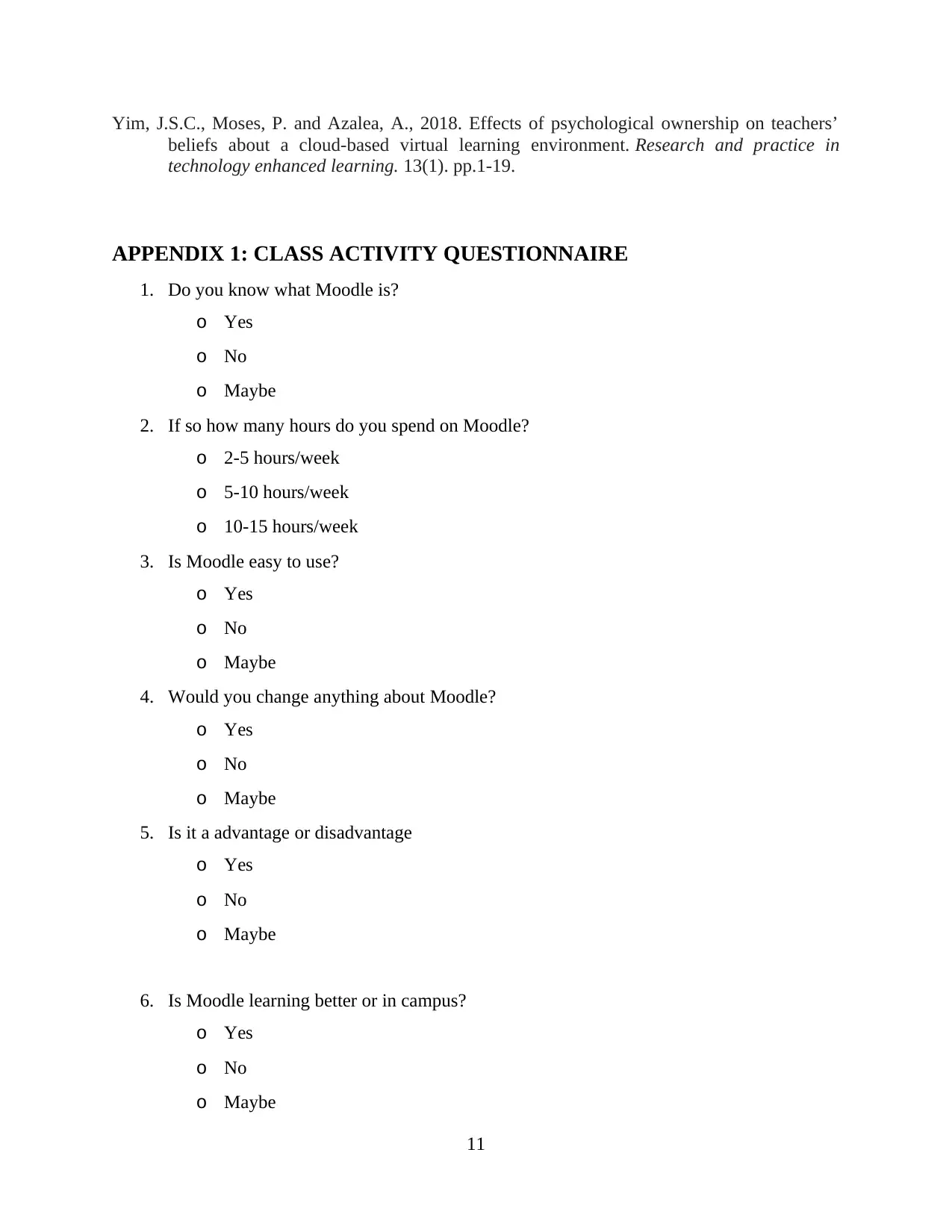
Yim, J.S.C., Moses, P. and Azalea, A., 2018. Effects of psychological ownership on teachers’
beliefs about a cloud-based virtual learning environment. Research and practice in
technology enhanced learning. 13(1). pp.1-19.
APPENDIX 1: CLASS ACTIVITY QUESTIONNAIRE
1. Do you know what Moodle is?
o Yes
o No
o Maybe
2. If so how many hours do you spend on Moodle?
o 2-5 hours/week
o 5-10 hours/week
o 10-15 hours/week
3. Is Moodle easy to use?
o Yes
o No
o Maybe
4. Would you change anything about Moodle?
o Yes
o No
o Maybe
5. Is it a advantage or disadvantage
o Yes
o No
o Maybe
6. Is Moodle learning better or in campus?
o Yes
o No
o Maybe
11
beliefs about a cloud-based virtual learning environment. Research and practice in
technology enhanced learning. 13(1). pp.1-19.
APPENDIX 1: CLASS ACTIVITY QUESTIONNAIRE
1. Do you know what Moodle is?
o Yes
o No
o Maybe
2. If so how many hours do you spend on Moodle?
o 2-5 hours/week
o 5-10 hours/week
o 10-15 hours/week
3. Is Moodle easy to use?
o Yes
o No
o Maybe
4. Would you change anything about Moodle?
o Yes
o No
o Maybe
5. Is it a advantage or disadvantage
o Yes
o No
o Maybe
6. Is Moodle learning better or in campus?
o Yes
o No
o Maybe
11

o Other
APPENDIX2: CLASS ACTIVITY EXCEL RESULT TABLE
APPENDIX2: CLASS ACTIVITY EXCEL RESULT TABLE
⊘ This is a preview!⊘
Do you want full access?
Subscribe today to unlock all pages.

Trusted by 1+ million students worldwide
1 out of 14
Related Documents
Your All-in-One AI-Powered Toolkit for Academic Success.
+13062052269
info@desklib.com
Available 24*7 on WhatsApp / Email
![[object Object]](/_next/static/media/star-bottom.7253800d.svg)
Unlock your academic potential
Copyright © 2020–2025 A2Z Services. All Rights Reserved. Developed and managed by ZUCOL.





